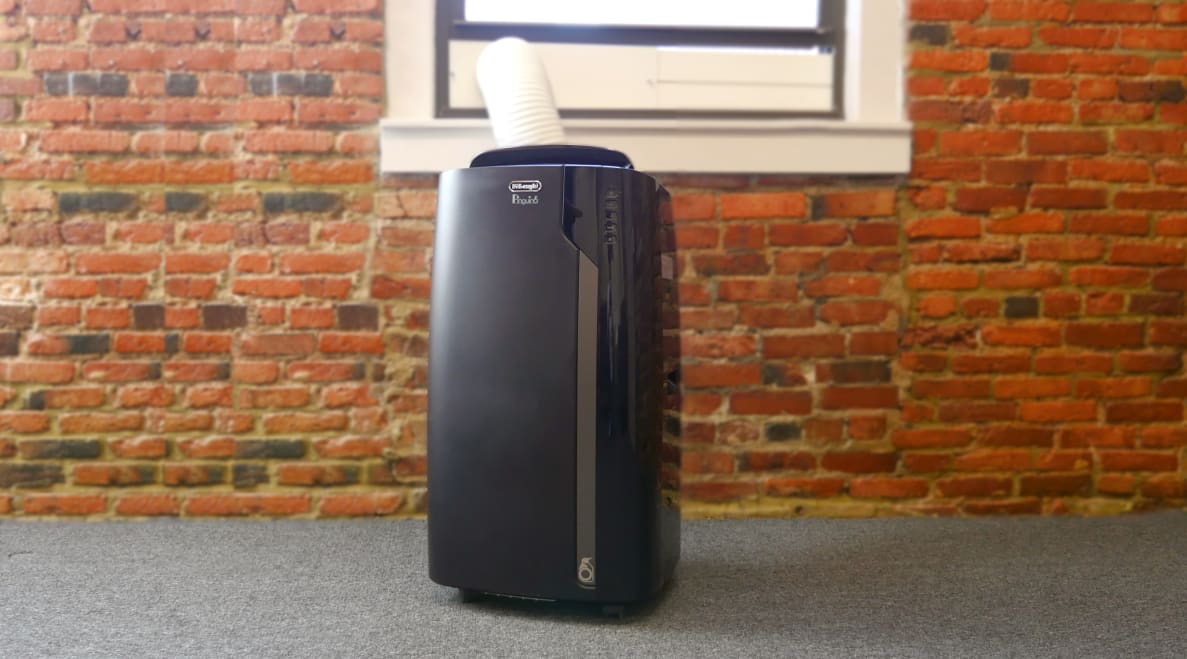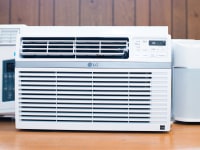Pros
-
Extra temp and humidity sensors
-
Excels at cooling large rooms
-
A multitude of features
Cons
-
Weighs in at 83.3 pounds
Design
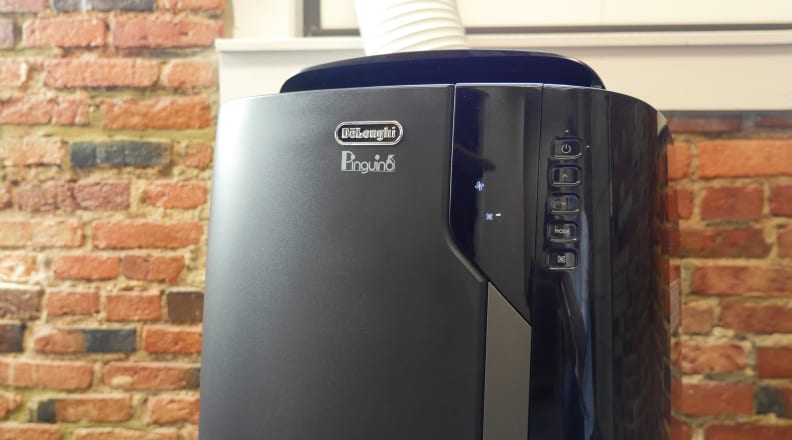
The Delonghi Pinguino is fairly elegant, as far as air conditioners go.
Some air conditioners beg to be hidden from view. The De’Longhi PACEX390LVYN Pinguino is quite the opposite. The bold, black mirror finish seems to want the attention and will pop in most rooms—not that it could hide if it even wanted to, weighing in at a massive 80 lbs and standing 34 inches tall.
Despite its bulk, the De’Longhi strives for elegance. Living up to its “Pinguino” name, it does bear some resemblance to a tuxedo-clad penguin. The control pad and digital readout follow suit, minimized so as to make it look as unlike an appliance as possible.
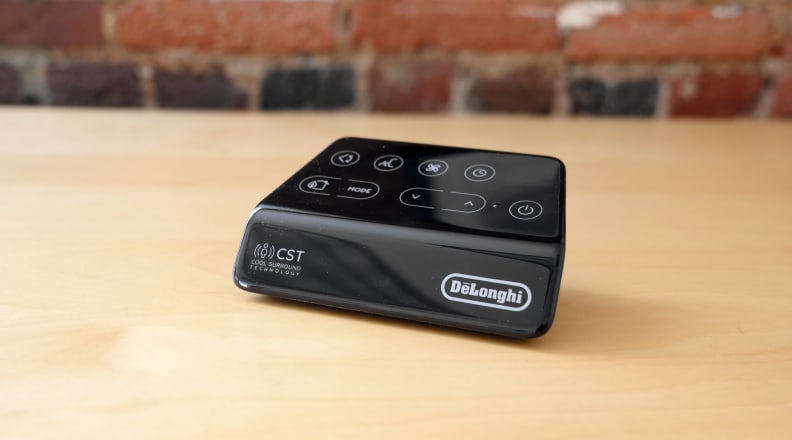
The remote contains additional temperature and humidity sensors.
A remote control, mirror black like the air conditioner, is also included. Considering how few buttons there are, you might think the remote could have been made much smaller. But the remote has built-in temperature and humidity sensors that can act like a portable thermostat for wherever you’re sitting in the room.
Features
The De’Longhi PACEX390LVYN Pinguino has a number of features designed to increase its utility under different weather conditions. It’s worth noting, however, that smart connectivity is not one of them. The benefit of being able to start the air cooling from an app before you arrive home at a stuffy house is appealing. If that’s must-have, check out the De’Longhi PACEL276HGRFK, which offers remote app control as well as the ability to act as a portable heater.
Air conditioning mode: Actively cools and dehumidifies the room. There are three fan speeds, plus an Auto speed setting.
Dehumidifying mode: Just reduces humidity. Same four fan speed settings.
Fan mode: The fan simply recirculates air in the room, so the exhaust fan does not need to be in place. Same four fan speed settings.
Cool Surround Technology: The included remote control contains a thermometer and humidity sensor that can be placed anywhere in the room (ideally where you’re sitting) to act as a hyper-local thermostat. Data is transmitted back to the air conditioner over Bluetooth.
Eco Real Feel: An auto-adjust mode that strives to identify and maintain the optimal temperature/humidity conditions, with better energy efficiency than other modes.
Arctic Whisper: A quiet mode.
Swing function: The conditioned air flap can be set to modulate up and down, distributing the air in a different pattern around the room.
Setting it up
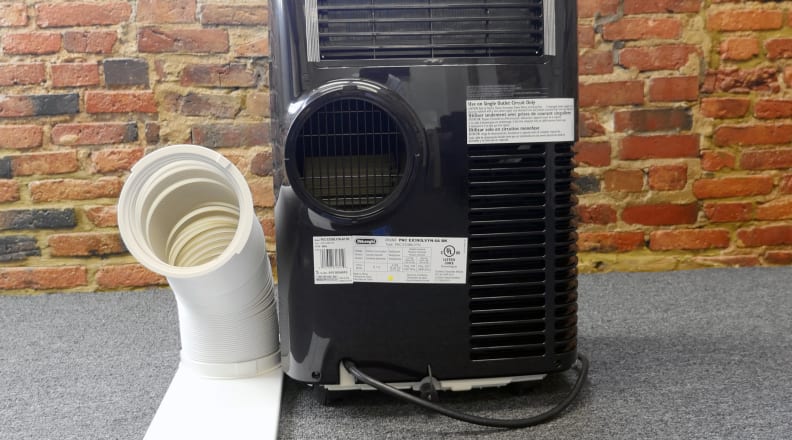
The filter on the back of the Delonghi Pinguino is easy to remove for cleaning.
Setting up the De’Longhi PACEX390LVYN Pinguino is easier than other portable air conditioners I’ve used, but not without its hiccups. The main benefit of portable air conditioners is that they are, of course, portable. The casters are smooth, which made rolling the unit around the house no problem. I also appreciated the intuitive locking system to connect the exhaust hose to the unit and the window bracket.
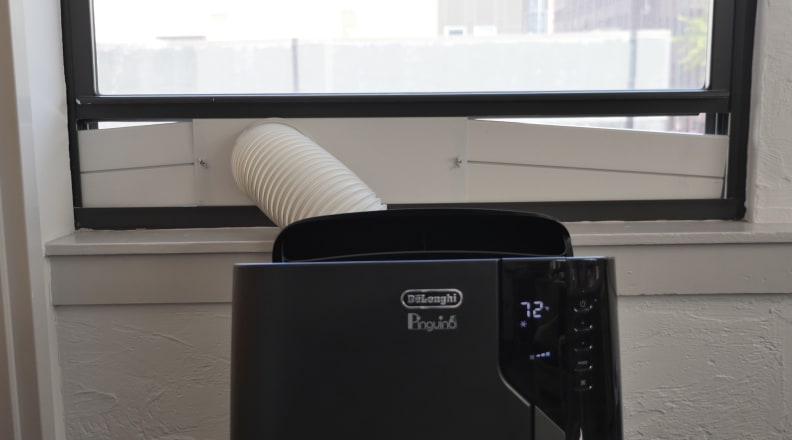
The wide, circular exhaust hose proved a tricky fit for my window, but those with a shallower sill may be fine.
Unlike many portable air conditioners, however, the point where the hose attaches to the window bracket is wide and perfectly round, rather than an oval. That proved to be a challenge for my particular window, which has a high lip at the sill. As a result, there was a big gap in the window that the bracket left exposed. It could easily be filled in with some cheap insulation from the hardware store, and if your own windows have a shallower sill you may not experience this problem at all, but it’s worth noting.
Performance
Data from the Reviewed labs is forthcoming. In my own casual usage, I found the De’Longhi PACEX390LVYN Pinguino a powerful air conditioner that could likely tackle big, hot rooms. It would be hard to describe any portable conditioner as “quiet” (except perhaps for portable evaporators, which function quite differently), but the De’Longhi was no louder than most. Despite its name, however, Arctic Whisper Mode was not substantially quieter than the low fan setting, at least not when the condenser was running.
What you should know about portable air conditioners
Portable air conditioners have a number of benefits that have driven their popularity of late. Unlike window units, portables have virtually no setup time, no risk of falling out the window, and can be easily removed on cooler days to let in fresh air. And for some, homeowner or condo association bylaws may prohibit window units.
The downside is that portables are inherently less energy-efficient than window units. Because the air conditioners work by removing heat from a room, the units themselves get hot. A window unit has the benefit of keeping the hot parts outside the home, while a portable’s entire body is in the room with you, thus contributing to the very heat problem you’re aiming to solve (as well as noise). What's more, single-hose portable air conditioners create negative air pressure, actually sucking warm air back into the room. Dual-hose portables avoid this particular issue, but they're a bit harder to find these days.
A few years ago, the U.S. Department of Energy (DOE) created a revised method for measuring BTUs—or, British thermal units, which is how air conditioners are rated for cooling power—for portables. This allows you to make better apples-to-apples comparisons with window units. If you’re out shopping for portables, you’ll see both sets of numbers. Thus, this De’Longhi has 14,000 BTU, or 8,600 BTU in the DOE’s reckoning. Not sure how much power you need? Check out the Energy Star guidelines for BTUs based on room size.
That said, certain room setups necessitate a portable air conditioner, and if you have a big space and limited options, the De’Longhi PACEX390LVYN Pinguino could make a great choice.
Final thoughts
The De’Longhi PACEX390LVYN Pinguino is a classy-looking workhorse of an air conditioner, as far as my experience went. Compared to other portables, the setup is simple and it would be very easy—even if you’re not particularly strong—to roll this around the house (just don’t try to lift it). Considering its size and BTU rating, this would be overkill for a small room, but if you have a large space and a portable air conditioner is your best option, the De’Longhi seems more than up to the task.
Meet the tester
David Kender oversees content at Reviewed as the Editor in Chief. He served as managing editor and editor in chief of Reviewed's ancestor, CamcorderInfo.com, helping to grow the company from a tiny staff to one of the most influential online review resources. In his time at Reviewed, David has helped to launch over 100 product categories and written too many articles to count.
Checking our work.
Our team is here to help you buy the best stuff and love what you own. Our writers, editors, and experts obsess over the products we cover to make sure you're confident and satisfied. Have a different opinion about something we recommend? Email us and we'll compare notes.
Shoot us an email